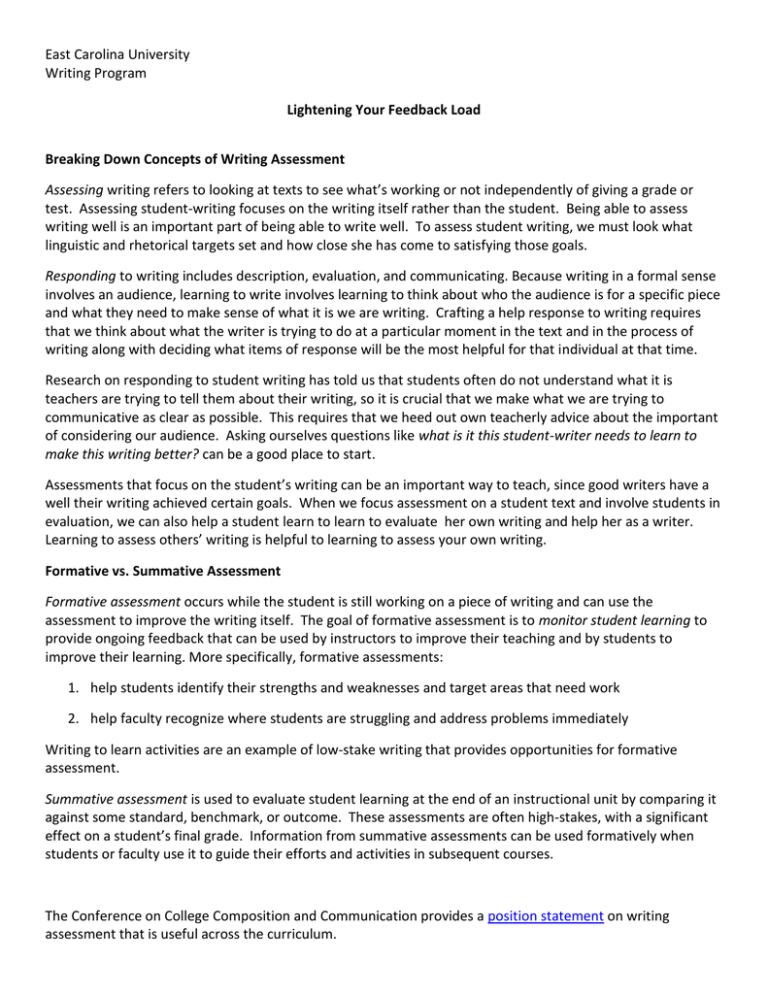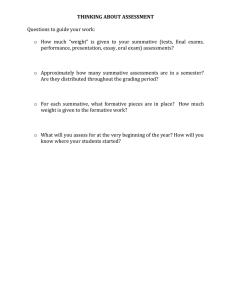Feedback
advertisement

East Carolina University Writing Program Lightening Your Feedback Load Breaking Down Concepts of Writing Assessment Assessing writing refers to looking at texts to see what’s working or not independently of giving a grade or test. Assessing student-writing focuses on the writing itself rather than the student. Being able to assess writing well is an important part of being able to write well. To assess student writing, we must look what linguistic and rhetorical targets set and how close she has come to satisfying those goals. Responding to writing includes description, evaluation, and communicating. Because writing in a formal sense involves an audience, learning to write involves learning to think about who the audience is for a specific piece and what they need to make sense of what it is we are writing. Crafting a help response to writing requires that we think about what the writer is trying to do at a particular moment in the text and in the process of writing along with deciding what items of response will be the most helpful for that individual at that time. Research on responding to student writing has told us that students often do not understand what it is teachers are trying to tell them about their writing, so it is crucial that we make what we are trying to communicative as clear as possible. This requires that we heed out own teacherly advice about the important of considering our audience. Asking ourselves questions like what is it this student-writer needs to learn to make this writing better? can be a good place to start. Assessments that focus on the student’s writing can be an important way to teach, since good writers have a well their writing achieved certain goals. When we focus assessment on a student text and involve students in evaluation, we can also help a student learn to learn to evaluate her own writing and help her as a writer. Learning to assess others’ writing is helpful to learning to assess your own writing. Formative vs. Summative Assessment Formative assessment occurs while the student is still working on a piece of writing and can use the assessment to improve the writing itself. The goal of formative assessment is to monitor student learning to provide ongoing feedback that can be used by instructors to improve their teaching and by students to improve their learning. More specifically, formative assessments: 1. help students identify their strengths and weaknesses and target areas that need work 2. help faculty recognize where students are struggling and address problems immediately Writing to learn activities are an example of low-stake writing that provides opportunities for formative assessment. Summative assessment is used to evaluate student learning at the end of an instructional unit by comparing it against some standard, benchmark, or outcome. These assessments are often high-stakes, with a significant effect on a student’s final grade. Information from summative assessments can be used formatively when students or faculty use it to guide their efforts and activities in subsequent courses. The Conference on College Composition and Communication provides a position statement on writing assessment that is useful across the curriculum. East Carolina University Writing Program Bless, Address, or Press Articulation of clear expectations about the type of feedback a writer provides structure and ideas of where the writer may be in their process. Bless, Address, or Press offers language for such articulation. When writers ask for bless, it indicates they When writers ask for address, it indicates they When writers ask for press, it indicates they Are not quite ready for a full blown critique of your work Share writing that is more reflective or highly personal Share writing that you do not plan to develop into a polished piece Share a piece that is just for fun or inspiration Have a specific areas of concern Need suggestions for where to go with the piece Have a strong piece of writing they think is a final draft Are ready to accept and understand suggestions made by others about their work Effective Feedback When examining the characteristics of courses respected most and considered effective by undergraduate students, a study performed at Harvard University by Professor Richard Light (1990) found that three primary features were shared among these courses. The first of these concerns the rapidity with which instructors offer students feedback on work done for the course. Students found that fast feedback helped work become a far better learning experience. Students also suggested having immediate feedback; a professor could give examples of correct responses as soon as an assignment is turned in. The second feature of effective courses Light found is early and frequent feedback. Students stated that better learning takes place when they are able to hand in an early draft of an assignment and get feedback before handing in their finished product, an equation that applies more aptly to courses heavy in writing rather than in the math and sciences courses. The third feature is closely related to feedback as well. Light explains that students feel that they learn best with frequent evaluation, rather than simply through a midterm and a final. Frequent evaluation serves as another kind of feedback to help the student become aware of what they do and do not understand. In concluding these observations, Light also notes that these results parallel those obtained at other institutions, implying that they are applicable outside of Harvard University.
